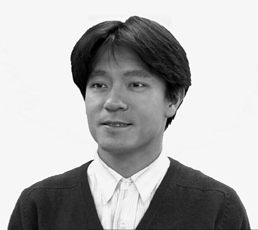
I was sent by FUJITSU LABORATORIES LTD. to work at the TRC in October of 1994. I am from Tokorozawa City, the home of the famous Seibu Lions baseball tearn. I arn honored to be the first staff scientist to be introduced in this column, but I wish I had more than the one week I was given to finish writing about rnyself due, I suspect, to this being the first issue of the RWC NEWS. To be safe, I will write about my dreams about the future. I will leave more creative writing to the persons who will write for the next issue.
The technology I am working toward can be called "creative intelligence." In essence, I am working to find holw to irnplernent an intellectual capability hurnans possess in creating new concepts in an intelligent system that is made up of computers and robots. Considering the fact that it was possible to conceptually discover atoms which are far too small to be seen by eyes, human creative power is a trernendously powerful capability. However, the essence of this power may be just an extension of the ability we routinely use in our daily lives to come up with new ideas or to apply existing ideas to solve minor problems.
Some of us could easily handle calculation problems but had some difficulty solving word problems when we took arithmetic examination in elementary school. Solving a word problern requires an ability that is different frorn sirnply calculating nurnbers. For example, to solve a word problem involving division, one must have the ability to find and appropriately substitute values given in the word problern to the numerator and denominator of a division equation.
The computers we currently use are not very good at solving word problerns, and we humans help by restating the problems in a computational format and lirniting the cornputer's function to sirnply performing the calculation. Why is it so difficult for computers to solve word problems? For example, if , as in the case of doing drill problerns in the classroorn, one is told to use division to solve a problem, it is a rather simple task to determine which values given in a word problem should be substituted for which terms in the equation.
However, the word problems given in a proficiency test require the student to identify rrhich cornputational tool to use, and trying to solve such problems by a trial and error method takes too much time. Smaller students are able to select the coirect combination of tools to use from a large number of possible combinations because they apparently have the tools stored in their brain in a manner that allows intuitive retrieval by an associative rnernory type process. Exactly how this is done is not clearly understood yet.
When creative intelligence technology is developed in the future, artificial scientists and artificial inventors rnay create new knowledge, enabling mankind to accumulate knowledge at a speed much faster than possible now. For the intelliEent system to truly surpass mankind's civilization level, it must be able to directly handle infoirnation from the real world. For this, the real world computing technology will be a very important basic technology. When the principle of creative intelligence is discovered, it may contribute to the elucidation of brain functions and the development of scientific brain training methods.
Incidentally, I am currently working on discovering the procedure by which an intelligent systern with rnultiple internal processing agents will be able to perforrn task division within the frarnework of reinforcement lea